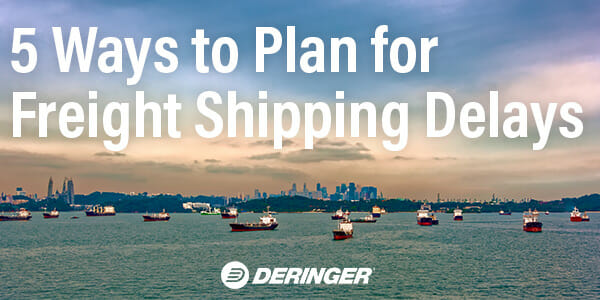Freight News:
5 Ways to Plan for Freight Shipping Delays

As shippers ring in the New Year expecting calmer waters, shipping industry insiders foresee stormy seas ahead. These experts predict continued supply chain disruptions, record port congestion, cargo delays, capacity shortages, and skyrocketing rates throughout 2022.
With these predictions in mind, how can shippers plan for sustained shipping delays and other disruptions as the shipping crisis of 2021 continues to rock the boat in 2022?
Knowing the source of these shipping delays, as well as proactively mitigating issues in advance, will help shippers navigate 2022’s chaotic shipping environment.
What is Causing Shipping Delays?
A perfect storm struck the shipping industry in 2021 and will continue throughout 2022.
When COVID-19 lockdowns were lifted, a crush of goods made landfall as manufacturers rushed to replenish depleted inventories and meet heightened consumer demand. The influx of ships increased port congestion and equipment shortages, while strained labor pools added to the fray.
Now, hundreds of thousands of containers sit on container ships waiting for a berth in U.S. ports and awaiting pickup at terminals. The logjams also stretch into inland freight yards, warehouses, and distribution centers across the United States.
But the crisis spans beyond the U.S. and Canada—it’s a worldwide issue. Today, ocean carrier reliability rests at around 30% globally. As your goods move from Point A to Point B, they will arrive on schedule only 30% of the time.
Land-side cargo is also continuously hit with further delays—truckers lack availability due to load arrivals delayed by more than 15 days. Railyard operators feel similar pressures as shortages of truck drivers, equipment, and warehouse workers add to the congestion. This has led to railroad operators often turning down business when shippers need them the most.
Further, shippers rely on air cargo as a backup when ocean carriers cannot get goods where they need to go. Though air freight is still faster than ocean transport, congestion has struck airlines, too. Fewer passenger flights due to COVID limit air freight space, meaning it now takes two weeks just to secure a spot on a cargo or passenger plane.
The omicron variant has generated additional concerns, as well. China maintains a zero-tolerance policy for COVID-19, shutting down ports without warning over a single case. The variant may also trigger lockdown measures, seafarer shortages, and border restrictions across the globe. These efforts may limit the number of sailings shipping companies can make.
5 Ways to Plan for Shipping Delays
In this chaotic shipping environment, there are steps shippers can take. Here, the best defense is a good offense when planning for the unexpected.
Improve Forecasts
The delays won’t change, but your response can. Forecasting makes life easier for every stakeholder in your supply chain and logistics team. Know your business, what you need, and which delays exist. Forecast far enough in advance to help your freight forwarder or NVO secure the space you need.
Split Bookings
Let’s say all your freight must get to a distribution center in Chicago. Here, you can ship your goods to the East or West Coasts. If you are unsure which route is the fastest, you can avoid issues by booking between the two. When goods get held up in one port, the other keeps things moving.
Shipping to the East Coast usually takes 45 days, compared to 30 days to the West Coast. But with West Coast port congestion, transit times no longer matter. The best choice for cargo is the least congested port.
Watch the Weather
Typhoons in China, flooding in India, volcano eruptions in Indonesia, tornadoes and wildfires across the U.S., and other weather disasters struck the globe in 2021. While you cannot control the weather, monitoring weather changes and considering different routing options in advance can save you. Cargo will keep moving because you’ll have time to diversify your shipping options and switch gears midstream.
Tackle Trucking Delays
A truck driver shortage continues to squeeze trucking capacity. The pandemic increased the pre-pandemic shortage of truck drivers by 23%. When you forecast well and communicate delays to your trucking partners, you can address trucking challenges at the destination. Pre-dispatch for trucking and continued updates can lead to fewer delays that save you money. Give trucking firms an idea of when goods will arrive to plan accordingly. It’s a lot easier to say, “Hey, I have goods coming in three weeks,” than to say, “My container just arrived. Can you pick it up?”
Connect with a Logistics Partner
If you haven’t already, reach out to a logistics partner to develop an effective strategy for meeting demand as delays crop up. These professionals can leverage their connections to keep goods moving as uncertainties arise.
Shipping delays will rock your boat well into 2022, but you can control the chaos. Forecast well and partner with a freight forwarder to keep goods moving as delays continue to disrupt shipping across the globe.